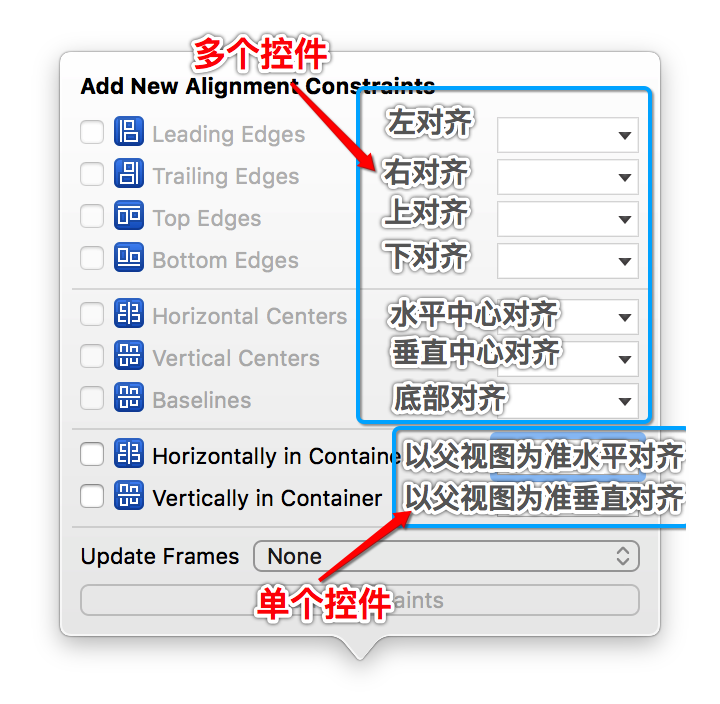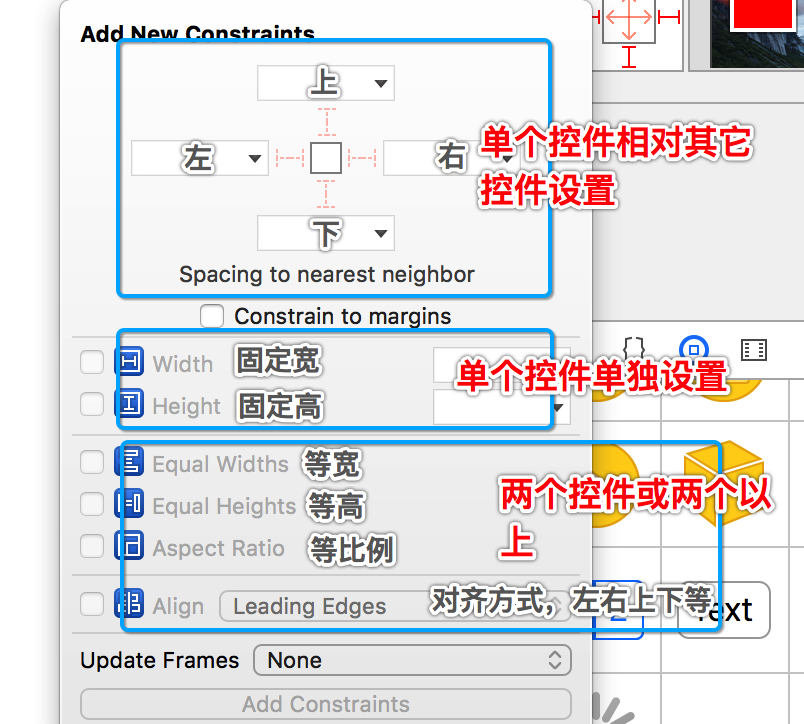这是 GitHub 上,Masonry 官方对 Masonry 的介绍:
Masonry is a light-weight layout framework which wraps AutoLayout with a nicer syntax. Masonry has its own layout DSL which provides a chainable way of describing your NSLayoutConstraints which results in layout code that is more concise and readable. Masonry supports iOS and Mac OS X.
译文如下:
Masonry 是一个轻量级的布局框架,它通过一种友好的语法封装了自动布局。Masonry 通过链式语法 DSL(Domain-specific language) 来封装 NSLayoutConstraints,使布局代码更加地简洁易读。Masonry 支持 iOS 和 Mac OS X。
在分析 Masonry 源码之前,有必要先说一下 Masonry 的基本使用,而在说 Masonry 的基本使用之前,我们还是先来看看 storyboard 以及 xib 中是如何进行 AutoLayout 的,我截了两张图:


从上图我们可以看出,在 storyboard 和 xib 中,我们可以在可视化界面对控件进行 AutoLayout,操作较为简单方便。Masonry 的实现原理与这很相似,接下来我们就一起看看如何使用 Masonry 进行自动布局。
先看一下 Masonry 支持哪些属性:
1
2
3
4
5
6
7
8
9
10
11
12
13
14
15
16
17
18
19
20
21
22
23
24
25
26
27
28
29
30
31
32
33
34
|
/**
* 以下属性返回一个新的 MASViewConstraint
*/
@property (nonatomic, strong, readonly) MASConstraint *left; // 左侧
@property (nonatomic, strong, readonly) MASConstraint *top; // 上侧
@property (nonatomic, strong, readonly) MASConstraint *right; // 右侧
@property (nonatomic, strong, readonly) MASConstraint *bottom; // 下侧
@property (nonatomic, strong, readonly) MASConstraint *leading; // 首部
@property (nonatomic, strong, readonly) MASConstraint *trailing; // 尾部
@property (nonatomic, strong, readonly) MASConstraint *width; // 宽
@property (nonatomic, strong, readonly) MASConstraint *height; // 高
@property (nonatomic, strong, readonly) MASConstraint *centerX; // 横向居中
@property (nonatomic, strong, readonly) MASConstraint *centerY; // 纵向居中
@property (nonatomic, strong, readonly) MASConstraint *baseline; // 文本基线
/**
* 返回一个 block 对象,block 的接收参数是 MASAttribute 类型,返回一个 MASCompositeConstraint 对象
*/
@property (nonatomic, strong, readonly) MASConstraint *(^attributes)(MASAttribute attrs);
/**
* 返回一个 MASConstraint 对象,包含上下左右的布局信息
*/
@property (nonatomic, strong, readonly) MASConstraint *edges;
/**
* 返回一个 MASConstraint 对象,包含宽高的布局信息
*/
@property (nonatomic, strong, readonly) MASConstraint *size;
/**
* 返回一个 MASConstraint 对象,包含 centerX 和 centerY 信息
*/
@property (nonatomic, strong, readonly) MASConstraint *center;
|
有了属性之后,怎样添加约束呢?使用 Masonry 添加约束的函数有三个,这三个方法我们在文件 View+MASAdditions 中可以查看到:
1
2
3
4
5
6
7
8
|
/// 新增约束
- (NSArray *)mas_makeConstraints:(void(NS_NOESCAPE ^)(MASConstraintMaker *make))block;
/// 更新约束
- (NSArray *)mas_updateConstraints:(void(NS_NOESCAPE ^)(MASConstraintMaker *make))block;
/// 清除旧约束,只保留新约束
- (NSArray *)mas_remakeConstraints:(void(NS_NOESCAPE ^)(MASConstraintMaker *make))block;
|
上面这三个方法中最常用的是 - (NSArray *)mas_makeConstraints:(void(NS_NOESCAPE ^)(MASConstraintMaker *make))block。即第一个,接下来我们就尝试一下。
举个栗子:
导入 Masonry 框架之后,添加以下代码:
1
2
3
4
5
6
7
8
9
10
11
12
13
|
- (void)layoutViews
{
UIImageView *imageView = [[UIImageView alloc] init];
[imageView setImage:[UIImage imageNamed:@"123"]];
[self.view addSubview:imageView];
[imageView mas_makeConstraints:^(MASConstraintMaker *make) {
make.left.equalTo(self.view).offset(100);
make.right.equalTo(self.view).offset(-100);
make.top.equalTo(self.view).offset(250);
make.bottom.equalTo(self.view).offset(-250);
}];
}
|
上面这几句代码便可以对 UIImageView 控件进行约束,这里还有两点值得一提。第一点:下面这三种方式会实现相同的效果
1
2
3
4
5
6
7
8
9
10
11
12
13
14
15
16
17
|
/// 第一种
[imageView mas_makeConstraints:^(MASConstraintMaker *make) {
make.left.equalTo(self.view).offset(100);
make.right.equalTo(self.view).offset(-100);
make.top.equalTo(self.view).offset(250);
make.bottom.equalTo(self.view).offset(-250);
}];
/// 第二种
[imageView mas_makeConstraints:^(MASConstraintMaker *make) {
make.top.bottom.left.right.equalTo(self.view).insets(UIEdgeInsetsMake(250, 100, 250, 100));
}];
/// 第三种
[imageView mas_makeConstraints:^(MASConstraintMaker *make) {
make.edges.equalTo(self.view).insets(UIEdgeInsetsMake(250, 100, 250, 100));
}];
|
三种方式得出的效果图一样:

第二点:必须先把控件添加到视图上,才能对控件进行布局,否则程序会崩。即先 addSubview:,再 mas_makeConstraints: 。
以上是对 Masonry 使用的简单介绍。接下来我们开始分析它的源码。
通过对 Masonry 使用方法的了解,我们可以看出 Masonry 的使用过程还是很简洁的
1
2
3
4
5
6
|
[imageView mas_makeConstraints:^(MASConstraintMaker *make) {
make.left.equalTo(self.view).offset(100);
make.right.equalTo(self.view).offset(-100);
make.top.equalTo(self.view).offset(250);
make.bottom.equalTo(self.view).offset(-250);
}];
|
那我们就从 mas_makeConstraints: 这个方法开始探寻 Masonry 的源码。上文说到,Masonry 中设置约束最常用的方法是
1
2
3
|
/// 新增约束
- (NSArray *)mas_makeConstraints:(void(NS_NOESCAPE ^)(MASConstraintMaker *make))block;
|
同时,Masonry 还提供两个类方法用于更新和重建约束
1
2
3
4
5
|
/// 更新约束
- (NSArray *)mas_updateConstraints:(void(NS_NOESCAPE ^)(MASConstraintMaker *make))block;
/// 清除旧约束,只保留新约束
- (NSArray *)mas_remakeConstraints:(void(NS_NOESCAPE ^)(MASConstraintMaker *make))block;
|
这里我们就以 mas_makeConstraints: 为切入点开始分析 Masonry 这个框架。mas_makeConstraints: 这个方法位于分类View+MASAdditions中,方法的实现如下:
1
2
3
4
5
6
7
8
9
10
11
|
/// 新增约束
- (NSArray *)mas_makeConstraints:(void(^)(MASConstraintMaker *))block {
/// 我们是手动添加约束,因此将自动转换关闭
self.translatesAutoresizingMaskIntoConstraints = NO;
/// 创建 MASConstraintMaker 对象
MASConstraintMaker *constraintMaker = [[MASConstraintMaker alloc] initWithView:self];
/// 通过 block 进行值的回调
block(constraintMaker);
/// 调用 install 方法
return [constraintMaker install];
}
|
该方法先去掉 AutoResizing 的自动转换(如果这个属性没有被正确设置,那么视图的约束不会被成功添加),接着初始化一个 MASConstraintMaker 对象,传递到 block 中,执行 block,最后调用 install 方法。
第一次点击进来看到这个方法之后,我有几处疑问。
- 第一,MASConstraintMaker 类内部做了什么操作?
- 第二,回调
block(constraintMaker) 有什么用?
- 第三,调用
[constraintMaker install] 方法实现了什么?
我们先来分析一下 MASConstraintMaker 这个类。MASConstraintMaker 是 Masonry 框架整个 DSL 过程的控制中心,它控制着整个添加过程,上文我们总结 Masonry 支持哪些属性时,总结的那些属性就来自 MASConstraintMaker 类。我们知道 Masonry 是基于 AutoLayout 进行的封装,所以接着我们一起来看下 MASConstraintMaker 是如何发挥作用的。下面是 MASConstraintMaker 的初始化
1
2
3
4
5
6
7
8
9
10
|
/// 这里的 MAS_VIEW 是一个宏,#define MAS_VIEW UIView
- (id)initWithView:(MAS_VIEW *)view {
self = [super init];
if (!self) return nil;
self.view = view;
self.constraints = NSMutableArray.new;
return self;
}
|
从上边代码中我们可以清晰的看出,Masonry 在初始化 MASConstraintMaker 时,将当前的 view 赋给 MASConstraintMaker 类,并初始化一个 constraints 的空可变数组,作为约束数组。
除此之外 MASConstraintMaker 还做了什么呢?
先来到 MASConstraintMaker 的头文件 MASConstraintMaker.h 中,下面是一些比较常规的属性
1
2
3
4
5
6
7
8
9
10
11
12
13
14
|
/**
* 以下属性返回一个新的 MASViewConstraint
*/
@property (nonatomic, strong, readonly) MASConstraint *left; // 左侧
@property (nonatomic, strong, readonly) MASConstraint *top; // 上侧
@property (nonatomic, strong, readonly) MASConstraint *right; // 右侧
@property (nonatomic, strong, readonly) MASConstraint *bottom; // 下侧
@property (nonatomic, strong, readonly) MASConstraint *leading; // 首部
@property (nonatomic, strong, readonly) MASConstraint *trailing; // 尾部
@property (nonatomic, strong, readonly) MASConstraint *width; // 宽
@property (nonatomic, strong, readonly) MASConstraint *height; // 高
@property (nonatomic, strong, readonly) MASConstraint *centerX; // 横向居中
@property (nonatomic, strong, readonly) MASConstraint *centerY; // 纵向居中
@property (nonatomic, strong, readonly) MASConstraint *baseline; // 文本基线
|
另外可以在 MASConstraintMaker 的 MASConstraintMaker.m 中看到另一个属性 @property (nonatomic, strong) NSMutableArray *constraints ,用来存储 MASConstraint
1
2
3
4
5
6
7
|
@interface MASConstraintMaker () <MASConstraintDelegate>
@property (nonatomic, weak) MAS_VIEW *view;
/// 存储 MASConstraint
@property (nonatomic, strong) NSMutableArray *constraints;
@end
|
接下来我们通过下面这个例子来分析上面这些属性:
1
2
3
|
[imageView mas_makeConstraints:^(MASConstraintMaker *make) {
make.top.bottom.left.right.equalTo(self.view).insets(UIEdgeInsetsMake(250, 100, 250, 100));
}];
|
- block 中首先会执行
make.top ,会先调用一个增加约束的通用方法- (MASConstraint *)addConstraintWithLayoutAttribute:(NSLayoutAttribute)layoutAttribute ,接着会调用 MASConstraintMaker 中 MASConstraintDelegate 的 - (MASConstraint *)constraint:(MASConstraint *)constraint addConstraintWithLayoutAttribute:(NSLayoutAttribute)layoutAttribute 方法。具体代码如下:
1
2
3
4
5
6
7
8
9
10
11
12
13
14
15
16
17
18
19
20
21
22
23
24
25
26
27
28
29
30
31
32
33
34
35
36
37
38
39
40
41
|
/// 重写 getter 方法
- (MASConstraint *)top {
return [self addConstraintWithLayoutAttribute:NSLayoutAttributeTop];
}
/// 增加约束的通用方法
- (MASConstraint *)addConstraintWithLayoutAttribute:(NSLayoutAttribute)layoutAttribute {
return [self constraint:nil addConstraintWithLayoutAttribute:layoutAttribute];
}
/// 通过 NSLayoutAttribute 添加约束
- (MASConstraint *)constraint:(MASConstraint *)constraint addConstraintWithLayoutAttribute:(NSLayoutAttribute)layoutAttribute {
/// 构造 MASViewAttribute
MASViewAttribute *viewAttribute = [[MASViewAttribute alloc] initWithView:self.view layoutAttribute:layoutAttribute];
/// 通过 MASViewAttribute 构造第一个 MASViewConstraint
MASViewConstraint *newConstraint = [[MASViewConstraint alloc] initWithFirstViewAttribute:viewAttribute];
/// 如果存在 contraint,则把 constraint 和 newConstraint 组合成 MASCompositeConstraint
if ([constraint isKindOfClass:MASViewConstraint.class]) {
//replace with composite constraint
NSArray *children = @[constraint, newConstraint];
MASCompositeConstraint *compositeConstraint = [[MASCompositeConstraint alloc] initWithChildren:children];
compositeConstraint.delegate = self;
/// 替换原来的 constraint 成新的 MASCompositeConstraint
[self constraint:constraint shouldBeReplacedWithConstraint:compositeConstraint];
return compositeConstraint;
}
/// 不存在则设置 constraint 到 self.constraints
if (!constraint) {
/// 设置delegate
newConstraint.delegate = self;
/// 将约束添加到self.constraints
[self.constraints addObject:newConstraint];
}
/// 返回刚刚创建的 MASViewConstraint 对象
return newConstraint;
}
|
值得一提的是,当调用 make.top 的时候会创建一个只有 firstViewAttribute 的 MASViewConstraint 对象,并且进入不存在 constraint 的代码部分,详情见代码块中的注释。
1
2
3
4
5
6
7
8
9
|
/// 不存在则设置 constraint 到 self.constraints
if (!constraint) {
/// 设置delegate
newConstraint.delegate = self;
/// 将约束添加到self.constraints
[self.constraints addObject:newConstraint];
}
/// 返回刚刚创建的 MASViewConstraint 对象
return newConstraint;
|
在这个方法的实现过程中,make.top 的返回值是 MASViewConstraint 对象。
- 当执行到
make.top.bottom 的时候,其实是对 MASViewConstraint 对象 .bottom 的调用,会走到 MASViewConstraint 中重写的 - (MASConstraint *)addConstraintWithLayoutAttribute:(NSLayoutAttribute)layoutAttribute 方法,然后最终还是会调用这个代理方法 - (MASConstraint *)constraint:(MASConstraint *)constraint addConstraintWithLayoutAttribute:(NSLayoutAttribute)layoutAttribute
1
2
3
4
5
6
7
8
9
10
11
12
13
14
15
16
17
18
19
20
21
22
23
24
25
26
27
28
29
30
31
32
33
34
35
36
37
|
- (MASConstraint *)addConstraintWithLayoutAttribute:(NSLayoutAttribute)layoutAttribute {
NSAssert(!self.hasLayoutRelation, @"Attributes should be chained before defining the constraint relation");
return [self.delegate constraint:self addConstraintWithLayoutAttribute:layoutAttribute];
}
/// 通过 NSLayoutAttribute 添加约束
- (MASConstraint *)constraint:(MASConstraint *)constraint addConstraintWithLayoutAttribute:(NSLayoutAttribute)layoutAttribute {
/// 构造 MASViewAttribute
MASViewAttribute *viewAttribute = [[MASViewAttribute alloc] initWithView:self.view layoutAttribute:layoutAttribute];
/// 通过 MASViewAttribute 构造第一个 MASViewConstraint
MASViewConstraint *newConstraint = [[MASViewConstraint alloc] initWithFirstViewAttribute:viewAttribute];
/// 如果存在 contraint,则把 constraint 和 newConstraint 组合成 MASCompositeConstraint
if ([constraint isKindOfClass:MASViewConstraint.class]) {
//replace with composite constraint
NSArray *children = @[constraint, newConstraint];
MASCompositeConstraint *compositeConstraint = [[MASCompositeConstraint alloc] initWithChildren:children];
compositeConstraint.delegate = self;
/// 替换原来的 constraint 成新的 MASCompositeConstraint
[self constraint:constraint shouldBeReplacedWithConstraint:compositeConstraint];
return compositeConstraint;
}
/// 不存在则设置 constraint 到 self.constraints
if (!constraint) {
/// 设置delegate
newConstraint.delegate = self;
/// 将约束添加到self.constraints
[self.constraints addObject:newConstraint];
}
/// 返回刚刚创建的 MASViewConstraint 对象
return newConstraint;
}
|
和前面的执行过程不同,因为 MASViewConstraint 的 delegate 对象是刚才设置过的 MASConstraintMaker 对象,并且因为 constraint 不是 nil,所以会进入
1
2
3
4
5
6
7
8
9
10
11
|
/// 如果存在 contraint,则把 constraint 和 newConstraint 组合成 MASCompositeConstraint
if ([constraint isKindOfClass:MASViewConstraint.class]) {
//replace with composite constraint
NSArray *children = @[constraint, newConstraint];
MASCompositeConstraint *compositeConstraint = [[MASCompositeConstraint alloc] initWithChildren:children];
compositeConstraint.delegate = self;
/// 替换原来的 constraint 成新的 MASCompositeConstraint
[self constraint:constraint shouldBeReplacedWithConstraint:compositeConstraint];
return compositeConstraint;
}
|
因此调用 make.top.bottom 返回的是一个 MASCompositeConstraint 对象。
- 当程序执行到
make.top.bottom.left 时,就是对 MASCompositeConstraint 中 .left 的调用,会走 MASCompositeConstraint 中的重写方法 - (MASConstraint *)addConstraintWithLayoutAttribute:(NSLayoutAttribute)layoutAttribute,接着会调用 - (MASConstraint *)constraint:(MASConstraint __unused *)constraint addConstraintWithLayoutAttribute:(NSLayoutAttribute)layoutAttribute方法,最终还是会调用 - (MASConstraint *)constraint:(MASConstraint *)constraint addConstraintWithLayoutAttribute:(NSLayoutAttribute)layoutAttribute。代码如下:
1
2
3
4
5
6
7
8
9
10
11
12
13
14
15
16
17
18
19
20
21
22
23
24
25
26
27
28
29
30
31
32
33
34
35
36
37
38
39
40
41
|
- (MASConstraint *)addConstraintWithLayoutAttribute:(NSLayoutAttribute)layoutAttribute {
[self constraint:self addConstraintWithLayoutAttribute:layoutAttribute];
return self;
}
- (MASConstraint *)constraint:(MASConstraint __unused *)constraint addConstraintWithLayoutAttribute:(NSLayoutAttribute)layoutAttribute {
id<MASConstraintDelegate> strongDelegate = self.delegate;
MASConstraint *newConstraint = [strongDelegate constraint:self addConstraintWithLayoutAttribute:layoutAttribute];
newConstraint.delegate = self;
[self.childConstraints addObject:newConstraint];
return newConstraint;
}
/// 通过 NSLayoutAttribute 添加约束
- (MASConstraint *)constraint:(MASConstraint *)constraint addConstraintWithLayoutAttribute:(NSLayoutAttribute)layoutAttribute {
/// 构造 MASViewAttribute
MASViewAttribute *viewAttribute = [[MASViewAttribute alloc] initWithView:self.view layoutAttribute:layoutAttribute];
/// 通过 MASViewAttribute 构造第一个 MASViewConstraint
MASViewConstraint *newConstraint = [[MASViewConstraint alloc] initWithFirstViewAttribute:viewAttribute];
/// 如果存在 contraint,则把 constraint 和 newConstraint 组合成 MASCompositeConstraint
if ([constraint isKindOfClass:MASViewConstraint.class]) {
//replace with composite constraint
NSArray *children = @[constraint, newConstraint];
MASCompositeConstraint *compositeConstraint = [[MASCompositeConstraint alloc] initWithChildren:children];
compositeConstraint.delegate = self;
/// 替换原来的 constraint 成新的 MASCompositeConstraint
[self constraint:constraint shouldBeReplacedWithConstraint:compositeConstraint];
return compositeConstraint;
}
/// 不存在则设置 constraint 到 self.constraints
if (!constraint) {
newConstraint.delegate = self;
[self.constraints addObject:newConstraint];
}
return newConstraint;
}
|
但这次 if ([constraint isKindOfClass:MASViewConstraint.class]) 与 if (!constraint) 都不会进入,只直接返回 MASViewConstraint 对象,然后回到 - (MASConstraint *)constraint:(MASConstraint __unused *)constraint addConstraintWithLayoutAttribute:(NSLayoutAttribute)layoutAttribute 方法中设置它的 delegate,并且将对象存入 MASCompositeConstraint 的 childConstraints 中。
-
之后再有更多的链式 MASConstraint 的组合(比如执行到 make.top.bottom.left.right),也只是 MASCompositeConstraint 的调用,直接加入 childConstraints 中即可。
-
至于 equalTo(self.view) 的调用过程,这里有必要说明一下,equalTo(self.view) 在文件 MASConstraint 中执行 - (MASConstraint * (^)(id))equalTo 方法,接着调用 MASViewConstraint 中的 - (MASConstraint * (^)(id, NSLayoutRelation))equalToWithRelation 方法。代码如下:
1
2
3
4
5
6
7
8
9
10
11
12
13
14
15
16
17
18
19
20
21
22
23
24
25
26
27
28
29
30
31
32
33
34
35
|
/// MASConstraint 是一个抽象类,其中有很多的方法都必须在子类中覆写。Masonry 中有两个 MASConstraint 的子类,分别是 MASViewConstraint 和 MASCompositeConstraint
/// MASConstraint.m
- (MASConstraint * (^)(id))equalTo {
return ^id(id attribute) {
return self.equalToWithRelation(attribute, NSLayoutRelationEqual);
};
}
/// MASViewConstraint.m
- (MASConstraint * (^)(id, NSLayoutRelation))equalToWithRelation {
return ^id(id attribute, NSLayoutRelation relation) {
if ([attribute isKindOfClass:NSArray.class]) {
NSAssert(!self.hasLayoutRelation, @"Redefinition of constraint relation");
NSMutableArray *children = NSMutableArray.new;
for (id attr in attribute) {
MASViewConstraint *viewConstraint = [self copy];
viewConstraint.layoutRelation = relation;
viewConstraint.secondViewAttribute = attr;
[children addObject:viewConstraint];
}
MASCompositeConstraint *compositeConstraint = [[MASCompositeConstraint alloc] initWithChildren:children];
compositeConstraint.delegate = self.delegate;
[self.delegate constraint:self shouldBeReplacedWithConstraint:compositeConstraint];
return compositeConstraint;
} else {
NSAssert(!self.hasLayoutRelation || self.layoutRelation == relation && [attribute isKindOfClass:NSValue.class], @"Redefinition of constraint relation");
self.layoutRelation = relation;
self.secondViewAttribute = attribute;
return self;
}
};
}
|
- (MASConstraint * (^)(id))equalTo 方法提供了参数 attribute 和布局关系 NSLayoutRelationEqual,这两个参数会传递到 - (MASConstraint * (^)(id, NSLayoutRelation))equalToWithRelation 中,设置 constraint 的布局关系和 secondViewAttribute 属性,为 [constraintMaker install] 做准备。
到这里基本上就把上文的那个例子说完了,通过例子让我们对 MASConstraintMaker 中的一些常规属性有了一定的了解,同时也明白了 block(constraintMaker) 这个方法的作用——在调用 block(constraintMaker) 时,对 constraintMaker 进行配置。 MASConstraintMaker 中还有一些别的属性,我们再一起来看看吧
1
2
3
4
5
6
7
8
9
10
11
12
13
14
15
16
17
18
19
|
/**
* 返回一个 block 对象,block 的接收参数是 MASAttribute 类型,返回一个 MASCompositeConstraint 对象
*/
@property (nonatomic, strong, readonly) MASConstraint *(^attributes)(MASAttribute attrs);
/**
* 返回一个 MASConstraint 对象,包含上下左右的布局
*/
@property (nonatomic, strong, readonly) MASConstraint *edges;
/**
* 返回一个 MASConstraint 对象,包含宽高的布局
*/
@property (nonatomic, strong, readonly) MASConstraint *size;
/**
* 返回一个 MASConstraint 对象,包含 centerX 和 centerY
*/
@property (nonatomic, strong, readonly) MASConstraint *center;
|
这里只简单的介绍一下上面的几个属性
attributes:返回一个 block 对象,block 的接收参数是 MASAttribute 类型,返回 MASCompositeConstraint 对象
edges:返回一个 MASConstraint 对象,同时包含了上下左右的布局size:返回一个 MASConstraint 对象,同时包含了宽高的布局center:返回一个 MASConstraint 对象,同时包含了 centerX 和centerY
接下来我们来分析 [constraintMaker install] 方法。
我们在- (NSArray *)mas_makeConstraints:(void(^)(MASConstraintMaker *))block 方法的最后会调用 [constraintMaker install] 方法来添加所有存储在 self.constraints 数组中的所有约束。
1
2
3
4
5
6
7
8
9
10
11
12
13
14
15
16
17
18
19
20
|
- (NSArray *)install {
/// 是否需要删除原来的约束
if (self.removeExisting) {
/// 获得所有约束
NSArray *installedConstraints = [MASViewConstraint installedConstraintsForView:self.view];
/// 删除所有约束
for (MASConstraint *constraint in installedConstraints) {
[constraint uninstall];
}
}
NSArray *constraints = self.constraints.copy;
for (MASConstraint *constraint in constraints) {
constraint.updateExisting = self.updateExisting;
[constraint install];
}
/// 去除所有缓存的约束结构体
[self.constraints removeAllObjects];
return constraints;
}
|
这个方法会先判断当前视图的约束是否需要删除,如果我们之前调用过 - (NSArray *)mas_remakeConstraints:(void(NS_NOESCAPE ^)(MASConstraintMaker *make))block 这个方法(它会把 removeExisting 的 BOOL 值设为 YES),那么视图中的原有约束就会被全被删除。接着往下走,程序会遍历 constraints 数组,发送 install 消息。
1
2
3
4
5
6
7
8
9
10
11
12
13
14
15
16
17
18
19
20
21
22
23
24
25
26
27
28
29
30
31
32
33
34
35
36
37
38
39
40
41
42
43
44
45
46
47
48
49
50
51
52
53
54
55
56
57
58
59
60
61
62
63
64
65
66
67
68
69
70
71
72
73
74
75
76
|
/// MASViewConstraint.m
- (void)install {
/// 已经有约束
if (self.hasBeenInstalled) {
return;
}
/// 支持 active 且已经有约束
if ([self supportsActiveProperty] && self.layoutConstraint) {
/// 激活约束
self.layoutConstraint.active = YES;
/// 添加约束缓存
[self.firstViewAttribute.view.mas_installedConstraints addObject:self];
return;
}
/// 获得 firstLayoutItem, firstLayoutAttribute, secondLayoutItem, secondLayoutAttribute
MAS_VIEW *firstLayoutItem = self.firstViewAttribute.item;
NSLayoutAttribute firstLayoutAttribute = self.firstViewAttribute.layoutAttribute;
MAS_VIEW *secondLayoutItem = self.secondViewAttribute.item;
NSLayoutAttribute secondLayoutAttribute = self.secondViewAttribute.layoutAttribute;
// alignment attributes must have a secondViewAttribute
// therefore we assume that is refering to superview
// eg make.left.equalTo(@10)
if (!self.firstViewAttribute.isSizeAttribute && !self.secondViewAttribute) {
secondLayoutItem = self.firstViewAttribute.view.superview;
secondLayoutAttribute = firstLayoutAttribute;
}
/// NSLayoutConstraint 的创建,生成约束,MASLayoutConstraint 其实就是 NSLayoutConstraint 的别名
MASLayoutConstraint *layoutConstraint
= [MASLayoutConstraint constraintWithItem:firstLayoutItem
attribute:firstLayoutAttribute
relatedBy:self.layoutRelation
toItem:secondLayoutItem
attribute:secondLayoutAttribute
multiplier:self.layoutMultiplier
constant:self.layoutConstant];
/// 设置 priority 和 mas_key
layoutConstraint.priority = self.layoutPriority;
layoutConstraint.mas_key = self.mas_key;
/// 如果 secondViewAttribute 有 view 对象
if (self.secondViewAttribute.view) {
/// 取得两个 view 的最小公共 view
MAS_VIEW *closestCommonSuperview = [self.firstViewAttribute.view mas_closestCommonSuperview:self.secondViewAttribute.view];
NSAssert(closestCommonSuperview,
@"couldn't find a common superview for %@ and %@",
self.firstViewAttribute.view, self.secondViewAttribute.view);
/// 设置约束 view 为此 view
self.installedView = closestCommonSuperview;
} else if (self.firstViewAttribute.isSizeAttribute) {
self.installedView = self.firstViewAttribute.view;
} else {
self.installedView = self.firstViewAttribute.view.superview;
}
/// 已经存在的约束
MASLayoutConstraint *existingConstraint = nil;
if (self.updateExisting) { // 需要更新
existingConstraint = [self layoutConstraintSimilarTo:layoutConstraint];
}
if (existingConstraint) { // 如果存在则替换约束
// just update the constant
existingConstraint.constant = layoutConstraint.constant;
self.layoutConstraint = existingConstraint;
} else {
/// 其它情况则直接添加约束
[self.installedView addConstraint:layoutConstraint];
self.layoutConstraint = layoutConstraint;
[firstLayoutItem.mas_installedConstraints addObject:self];
}
}
|
上面这个方法是为当前视图添加约束的最后的方法,首先这个方法会先获取即将用于初始化 NSLayoutConstraint 的子类的几个属性
1
2
3
4
5
6
7
|
/// MASViewConstraint.m
/// 获得 firstLayoutItem, firstLayoutAttribute, secondLayoutItem, secondLayoutAttribute
MAS_VIEW *firstLayoutItem = self.firstViewAttribute.item;
NSLayoutAttribute firstLayoutAttribute = self.firstViewAttribute.layoutAttribute;
MAS_VIEW *secondLayoutItem = self.secondViewAttribute.item;
NSLayoutAttribute secondLayoutAttribute = self.secondViewAttribute.layoutAttribute;
|
然后判断当前即将添加的约束,如果不是 size 类型并且没有提供 self.secondViewAttribute,会自动将约束添加到 superview 上
1
2
3
4
5
|
/// MASViewConstraint.m
if (!self.firstViewAttribute.isSizeAttribute && !self.secondViewAttribute) {
secondLayoutItem = self.firstViewAttribute.view.superview;
secondLayoutAttribute = firstLayoutAttribute;
}
|
接着创建 MASLayoutConstraint 对象
1
2
3
4
5
6
7
8
9
10
11
12
13
14
|
/// MASViewConstraint.m
/// NSLayoutConstraint 的创建,生成约束,MASLayoutConstraint 其实就是 NSLayoutConstraint 的别名
MASLayoutConstraint *layoutConstraint
= [MASLayoutConstraint constraintWithItem:firstLayoutItem
attribute:firstLayoutAttribute
relatedBy:self.layoutRelation
toItem:secondLayoutItem
attribute:secondLayoutAttribute
multiplier:self.layoutMultiplier
constant:self.layoutConstant];
/// 设置 priority 和 mas_key
layoutConstraint.priority = self.layoutPriority;
layoutConstraint.mas_key = self.mas_key;
|
创建完约束对象后,我们要寻找该约束添加到那个 View 上。下方的代码段就是获取接收该约束对象的视图。如果是两个视图相对约束,就获取两种的公共父视图。如果添加的是 Width 或者 Height,那么就添加到当前视图上。如果既没有指定相对视图,也不是 Size 类型的约束,那么就将该约束对象添加到当前视图的父视图上。代码实现如下:
1
2
3
4
5
6
7
8
9
10
11
12
13
14
15
16
|
/// MASViewConstraint.m
/// 如果 secondViewAttribute 有 view 对象
if (self.secondViewAttribute.view) {
/// 取得两个 view 的最小公共 view
MAS_VIEW *closestCommonSuperview = [self.firstViewAttribute.view mas_closestCommonSuperview:self.secondViewAttribute.view];
NSAssert(closestCommonSuperview,
@"couldn't find a common superview for %@ and %@",
self.firstViewAttribute.view, self.secondViewAttribute.view);
/// 设置约束 view 为此 view
self.installedView = closestCommonSuperview;
} else if (self.firstViewAttribute.isSizeAttribute) {
self.installedView = self.firstViewAttribute.view;
} else {
self.installedView = self.firstViewAttribute.view.superview;
}
|
加约束时我们要判断是否需要对约束进行更新,如果需要,就替换约束,如果不需要就直接添加约束即可。添加成功后我们将通过 mas_installedConstraints 属性记录一下本次添加的约束。
1
2
3
4
5
6
7
8
9
10
11
12
13
14
15
|
/// 已经存在的约束
MASLayoutConstraint *existingConstraint = nil;
if (self.updateExisting) { // 需要更新
existingConstraint = [self layoutConstraintSimilarTo:layoutConstraint];
}
if (existingConstraint) { // 如果存在则替换约束
// just update the constant
existingConstraint.constant = layoutConstraint.constant;
self.layoutConstraint = existingConstraint;
} else {
/// 其它情况则直接添加约束
[self.installedView addConstraint:layoutConstraint];
self.layoutConstraint = layoutConstraint;
[firstLayoutItem.mas_installedConstraints addObject:self];
}
|
到此为止,对 Masonry 源码的简单介绍已接近尾声了。。。Masonry 的代码流程简单来讲就是提供给我们一个 MASConstraintMaker,然后我们根据 Masonry 提供的语法,添加约束。最后 Masonry 解析约束,将真正的约束关系添加到相应的视图上。


